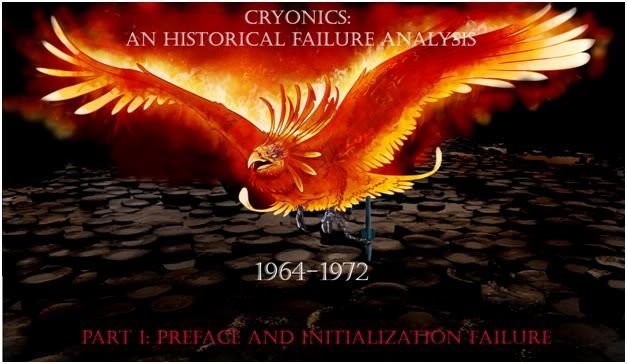
By Mike Darwin
FAILURE OF HUSBANDRY
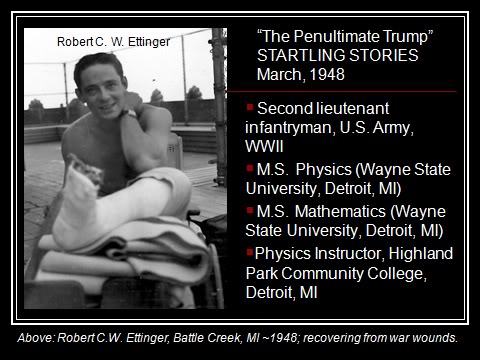
SLIDE 34
The core ideas of cryonics, that death is a function of remaining biological structure (information), technological sophistication, and that deep cooling can arrest decay and preserve structure indefinitely to await resurrection by a more sophisticated future medical technology were first promulgated by Robert Chester Wilson Ettinger in a science fiction story, The Penultimate Trump, in 1948.
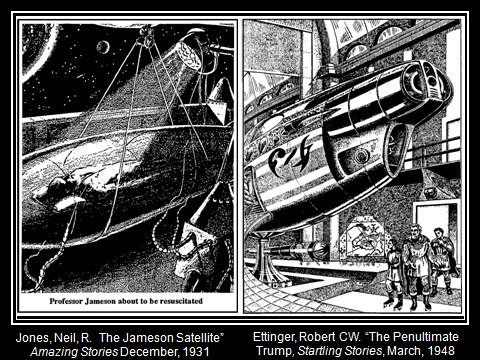
SLIDE 35
Ettinger did nothing beyond laying the idea out in his story until 1962, at which time he began to be concerned that no one else had come to the same conclusions he had. It occurred to him that if he did not act to at least inject the idea into the culture, he might not benefit from it himself. Ettinger, in turn, had been inspired to create cryonics based on a 1931 science fiction story, The Jameson Satellite by Neil R. Jones, in which one Professor Jameson has his body rocketed into orbit following his death where he remains, frozen, until many millennia later his brain is removed and repaired by aliens, the Zoromes, who place him in a robotic body and allow him to accompany them on their romps around the galaxy.

SLIDE 36
At about the same time, an intellectual and remittance man named Evan (Ev) Cooper had come to the same conclusions as had Ettinger and he privately published a manuscript that proposed a “freezer program.” Cooper, unlike Ettinger, had no scientific training and his proposals for using arctic or Antarctic storage lacked scientific rigor.
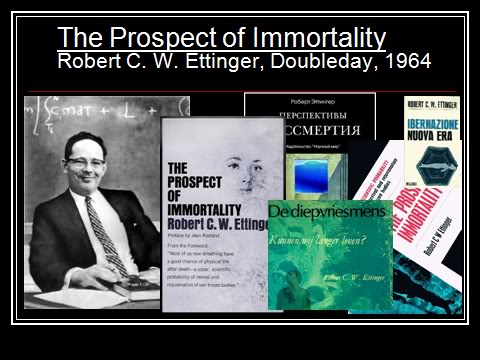
SLIDE 37
In 1964 Ettinger published The Prospect of Immortality after it passed scientific review by universally respected experts at the time, such as Isaac Asimov and the maverick cardiac surgeon and cryobiologist Richard Lillihei.
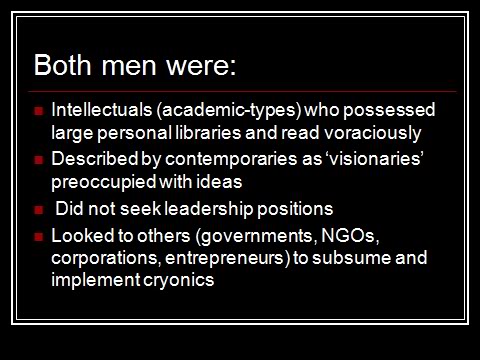
SLIDE 38
Aside from the idea of cryonics, Cooper and Ettinger had a number of other things in common. Both men were intellectuals (academic-types) who possessed large personal libraries, read voraciously and were described by their contemporaries as “visionaries” preoccupied with ideas. Both men sought leadership positions, and both men looked to others (governments, NGOs, corporations, entrepreneurs) to subsume and implement cryonics.

SLIDE 39
Their personalities were those of the classic introvert. I want to be at pains to point out that this is in no way a criticism of either man. In general, we do not get to pick our personalities or temperaments, and these men were what they were: there is no fault or blame involved in being either an extrovert or an introvert.

SLIDE 40
Both men saw cryonics as integrating into and augmenting the existing cultural paradigm; Cooper, from a left of centre perspective, believed cryonics should be implemented by the United Nations and administered from a top-down, central-planning perspective as a public welfare measure, while Ettinger, from a right of centre perspective, envisioned cryonics being implemented by large corporations and entrepreneurs offering a wide range of services in a largely laissez faire manner.
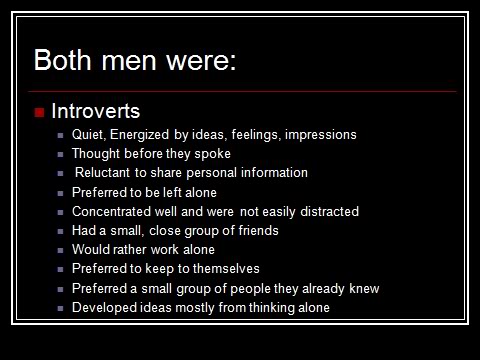
SLIDE 41
Nevertheless, these traits had consequences for cryonics that were, on balance, not conducive to its successful launch. Things might have been different if either man had had a Huxley to his Darwin – a vigorous, outspoken, charismatic, articulate and, above all, honest and well informed advocate of their ideas.

SLIDE 42
Precisely for the reasons outlined above, two highly influential men who understood cryonics, and believed in its technical feasibility, rejected it, one personally and privately, and the other vocally and publicly. The science fiction writer, savant and media darling Isaac Asimov, understood immediately that cryonics would up-end the existing order and ultimately lead to a fundamental transformation of mankind into something other than human. He found this extremely disturbing and “unnatural,” and wrote and spoke extensively against cryonics on social, environmental and moral grounds.
The widely respected science fiction author and futurist Fred Pohl also understood the likely workability of cryonics and in fact wrote a very positive cryonics themed novel, The Age of the Pussyfoot (first published in 1966). Pohl rejected cryonics exclusively on the basis of survivorship guilt and concern over his ability to adapt to a world transformed by technologies even he might not be able to imagine. Pohl actually turned down an offer for a no-cost cryopreservation from me and several others active in cryonics on September 1st, 1979, and he expressed his reasons for doing so pleasantly, articulately and in person.
FIRST ERA: 1964-1972
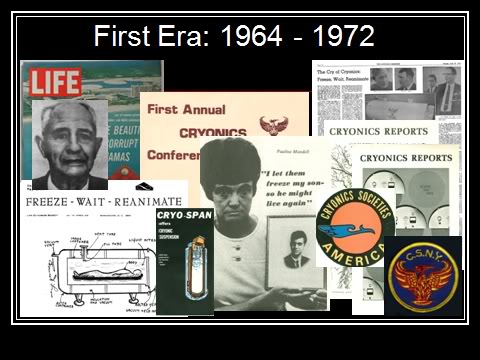
SLIDE 43
Despite these shortcomings and setbacks, cryonics was initially received fairly well in the US. There was enormous publicity and most of the initial newspaper, radio, magazine and
TV coverage was open minded, and not infrequently positive. There was a great deal of public interest, and media appearances by Ettinger, and others, typically resulted in hundreds of requests for information.
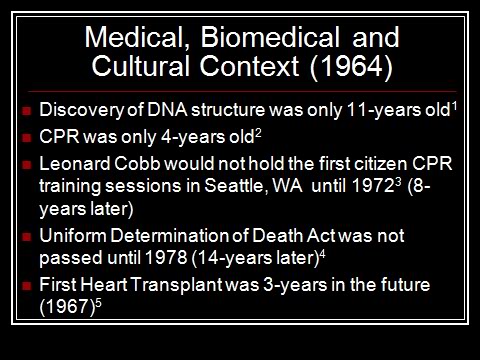
SLIDE 44
But the culture, both scientific and popular, was woefully unprepared for the idea. It is difficult, today, to communicate what the world was like in 1964. The discovery of the structure of DNA was only 11-years old, CPR was only 4-years old (Leonard Cobb would not hold the first citizen CPR training sessions in Seattle, WA until 1972 (8 years later), the Uniform Determination of Death Act was not passed until 1978 (14-years later) and the first heart transplant was 3-years in the future (1967). People uniformly saw life and death as binary states and the idea that the soul, or some other mystical life force left the body at, or shortly after the moment of death, was nearly universal in the general population.
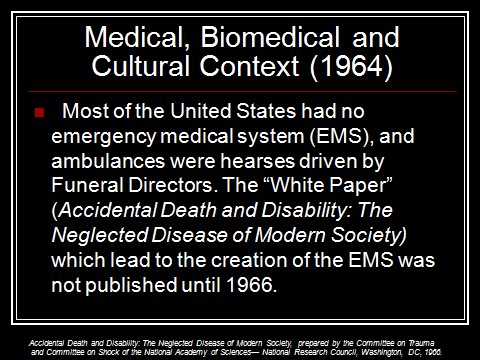
SLIDE 45
Recovery from apparent (clinical) death which, is now widely understood and taken for granted, was a new phenomenon in 1964, and the Emergency Medical System (EMS) as we understand it today, did not exist. In most communities the mortician‘s hearse doubled as the ambulance and the person most likely to transport you to the hospital if you were gravely ill or injured was your local Funeral Director, or one of his embalmer employees.

SLIDE 46
It is debatable whether these formidable cultural obstacles could have been overcome. But what is not in dispute is that overcoming them was hopeless in the absence of careful planning and entrepreneurship of the cryonics idea. Both Ettinger and Cooper abdicated any responsibility for implementation of cryonics to others, and neither made any real efforts at a first approximation of the technological specifications or necessary business planning.
In Ettinger’s case, he uncritically and actively endorsed con men, frauds and the incompetent – actions that were to badly damage the credibility of cryonics with people of means and influence, as well as those in the scientific community and the professions.

SLIDE 47
Powerful, paradigm changing ideas require careful husbandry and meticulous planning. A good example of this that stands in sharp contrast to cryonics, is the idea of molecular nanotechnology, as first articulated and promulgated by Eric Drexler. Drexler understood not only the potential benefits of nanotechnology, but also its downsides: its nearly endless capacity for harm, ranging from mischief to catastrophe.
He also understood the need to back up general statements and assertions about the capabilities of nanotechnology with detailed scientific analysis and modeling. He did not write Engines of Creation and stop there; he followed through with Nanosystems, and he surrounded himself with talented, honest, competent and articulate people who could and did promote his ideas in a responsible way – to extraordinarily favorable reception. It is worth noting that Drexler, like Ettinger and Cooper, is also an introvert who shares most of the same personality traits with both men.

SLIDE 48
Drexler was both a scientist and an engineer, and he approached communication of his ideas to both the scientific community and the public, with care and precision. He clearly defined terms and, where necessary, created new language to express ideas that could not be effectively communicated otherwise. By contrast, those promoting cryonics gave no thought to making important semantic distinctions, such as the difference between the sloppy and imprecise contemporary medico-legal definitions of death, and the new reality that cryonics implied.

SLIDE 49
Similarly, identification and alliance of cryonics with the mortuary and cemetery trades (as opposed to the medical and scientific professions), and failure to develop any in-house standards of care; either technical or financial; lead to a total failure to professionalize cryonics.

SLIDE 50
This in turn led to the empowerment of amateurs and laypersons, usually with “outsider” personalities, often with accompanying deficits in social and emotional intelligence. These people attracted dysfunctional and sometimes frankly sociopathic personalities as members (and sometimes as activists). The problem of sociopaths in positions of power and authority in cryonics is a serious one which I will return to in detail later in these lectures.
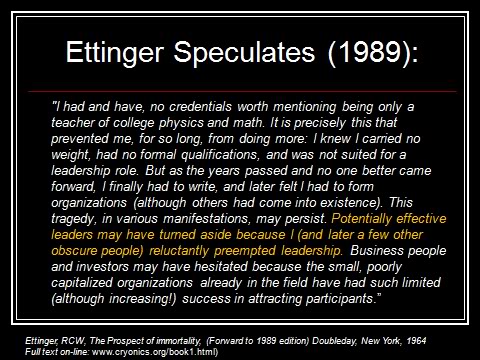
SLIDE 51
In a rare moment of candor, Ettinger came close to acknowledging this interpretation of the failure of cryonics to launch, as possibly being material to how things turned out, and implicit in this statement is the acknowledgement that cryonics ‗failed,‘ that it did not succeed in either becoming a dominant force in the culture, or even in establishing itself as a respected (or feared) minority player. Consider, by contrast, the outcome for Scientology, a movement started by another of Ettinger‘s cohorts (fellow science fiction writer L. Ron Hubbard) 11 years earlier, in 1953.
Today Scientology is a multimillion dollar enterprise that makes or breaks legislation in the US, elects representatives to Congress, tell the IRS what to do, and has at least 50,000 hard core adherents in the US alone. While it is a tiny entity, and has by no means come to dominate the culture, it has managed to survive withering attacks and to carve out a place of safe harbor and exert enormous political influence relative to its size. That happened because of careful planning and clever strategizing. It was no accident and it was by no means inevitable.

SLIDE 52
And this brings us to the all important question, ―What was, at a minimum, required to launch cryonics successfully in 1964 – and perhaps more to the point, what are the implications for cryonics today; particularly as it is presented to new cultures that are effectively tabula rasa with respect to cryonics? The former Soviet Union and China are two prime examples of places where cryonics has not penetrated the culture: or is just beginning to.
Are there lessons to be learned and mistakes to be avoided from the first period of failure in the US? Are the nascent cryonics groups in these ‗new markets‘ behaving responsibly, are they repeating the mistakes made by those of us in the US from 1964 to 1972?
To answer that question it is necessary to spec out what should have happened in 1964. First, there needed to be a thorough explication of all the required technical elements of the program including necessary equipment (all phases of program), required personnel and their qualifications, an analysis of the market and obstacles to implementation of the proposed program. And, of course, essential to any complex enterprise, there needed to be a business plan including corporate structure (profit, NGO, etc.), cost estimation, timeline to implementation…and so on. None of his was done.

SLIDE 53
To make clear what I‘m talking about here, I’ve created a block diagram of the vital elements of any cryonics operation, whether being created in 1964, or today. This is the bare minimum framework of functional elements required. Each of these, in turn, breaks down into supporting subsystems.
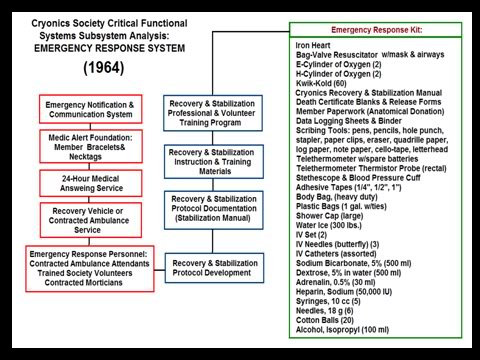
SLIDE 54
As an example, I’ve chosen the Emergency Response System (ERS) because it is the first link in the chain of member recovery in the event of life threatening illness or cardiac arrest. If the Cryonics Society (CS) can neither be reached nor respond when members or clients need them, then they have little to offer in the way of effective services, and certainly, they have nothing to offer in terms of confidence.
I’ve also listed every item, from cotton balls to capital equipment, required to undertake stabilization and transport based on what the technology available in 1964. These assets, both physical and organizational, may seem impossible to have achieved then, and may seem equally impossible to achieve now, in places where cryonics is starting over, or starting out for the first time.
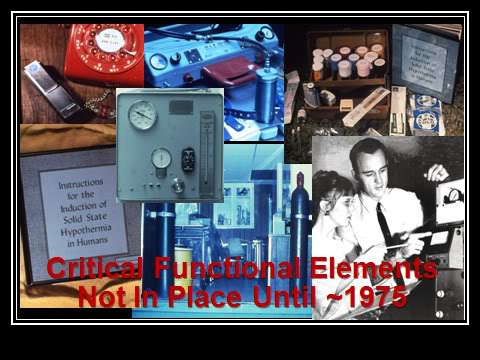
SLIDE 55
However, history shows this is not the case, and I am in the unique position of having been both a witness and a participant in events that prove that it was possible to put all of these critical elements in place using a handful of people and far less resources (dollars expended) than were brought to bear on the failed launch of cryonics during the first 8 years of its existence in the US.
This slide shows what was achieved by 4 activist individuals who were part of a group of less than 30 people. Single-handedly, the Chamberlains wrote a comprehensive procedure manual and established best practices documentation (Standard Operating Procedures; SOPs in the US and Canada) to support it. They detailed protocols for taking call (responding to an emergency when the Alcor pager went off), hired a medical answering service to field emergency calls, developed and deployed emergency response kits and trained volunteer staff to administer cryonics first aid: manual & mechanical CPR, external cooling, anticoagulation & buffer administration, and transportation of the patient.
They built and tested perfusion equipment, contracted with an ambulance company and mortuary for technical and transportation services and, finally, constructed a mobile perfusion facility where cryoprotective perfusion and freezing could be carried out.
In addition to all of this, they kept the books, put out a technical publication, Manrise Technical Review, and practiced and drilled relentlessly to hone their skills and familiarize themselves with the equipment they would be using. And before they did any of this, they created a business plan which was realistic and scaled to the (very small) market they estimated they would be servicing.
And, I should add, all of us were employed full time during this period at demanding jobs; Linda was an executive secretary, Fred was an IEEE at the Jet Propulsion Laboratories and I was a full time student putting in 30-40 hr/wk at McDonald‘s (literally making hamburgers). Total dollars expended (adjusted for inflation) = $350,000.
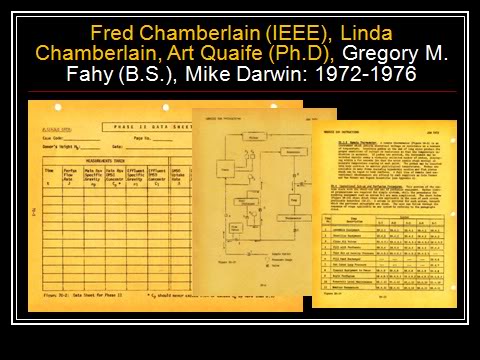
SLIDE 56
Data collection sheets, flow charts and thorough documentation on how to use equipment, prepare perfusate and carry out cryoprotective perfusion and freezing were all put in place and rigorously validated before the first Alcor patient presented for care in the summer of 1976. Our competence and attention to detail had the effect of quickly attracting the best
and brightest in cryonics to Alcor (and Trans Time) and our professionalism ultimately attracted and deeply involved medically competent individuals such as Allen McDaniels, M.D., Jerry Leaf, Virginia Jacobs, and others. To approach cryonics with anything less than this is not merely to invite disaster, it is to ensure it.
End of Initialization Failure, Part 2
